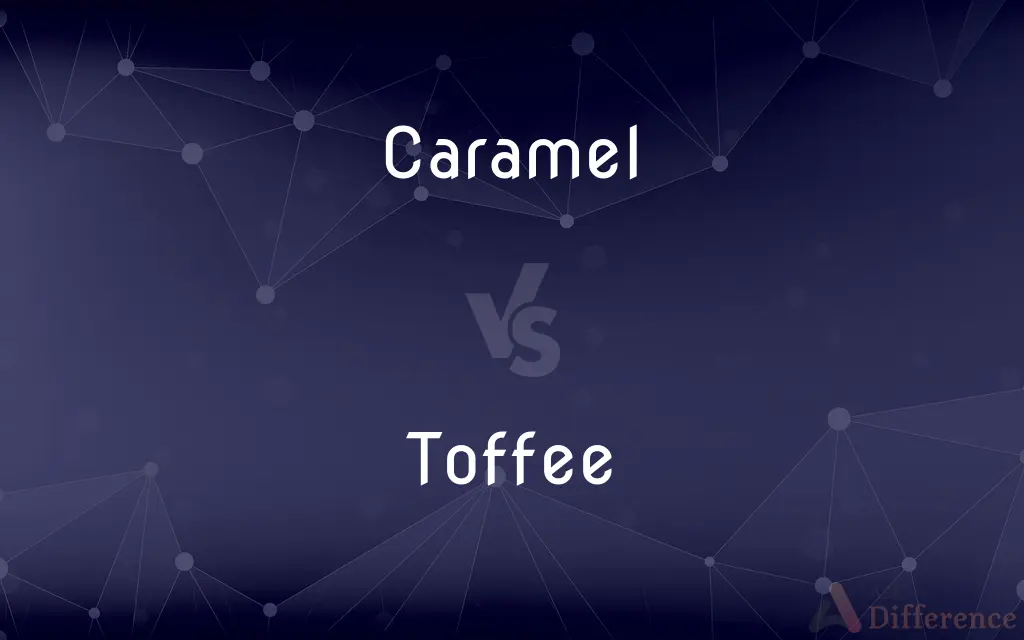Caramel vs. Toffee — What's the Difference?
Edited by Tayyaba Rehman — By Fiza Rafique — Updated on October 6, 2023
Caramel is a sweet made by heating sugar, often with butter or milk. Toffee is a hard candy made by boiling sugar and butter together.

Difference Between Caramel and Toffee
Table of Contents
ADVERTISEMENT
Key Differences
Caramel is renowned for its smooth, often sticky consistency and is crafted by heating sugar until it browns. Toffee, conversely, holds a markedly harder and oftentimes brittle texture, resulting from a mixture of sugar and butter boiled together.
Utilization in culinary worlds witnesses Caramel being employed in various forms like sauces, candies, and toppings, showcasing its versatile character. Toffee, with its crisp nature, predominantly takes a solitary form, but brings a rich, buttery sweetness to confections.
The method of preparation is distinctive where Caramel is concerned with the heating and browning of sugar, sometimes alongside dairy. Toffee demands precision in its preparation, requiring the sugar and butter mixture to reach a particular temperature to achieve its signature hardness.
In the realm of flavors, Caramel tends to exude a mild, milky sweetness, often with a slightly burnt undertone due to caramelized sugars. Toffee, while also sweet, leans heavily into a buttery, rich profile, presenting a luxuriousness in its taste.
From a global perspective, Caramel is ubiquitously recognized and employed in myriad culinary traditions, embellishing dishes with its sweet, velvety charm. Whereas Toffee, despite its international presence, can be particularly associated with certain regions, such as the United Kingdom, where it is a staple in many traditional sweets.
ADVERTISEMENT
Comparison Chart
Basic Ingredients
Sugar, potentially with butter or milk.
Sugar and butter, sometimes with milk.
Texture
Generally soft and sticky.
Hard and often brittle.
Flavor Profile
Sweet, sometimes with a burnt undertone.
Rich, sweet, and notably buttery.
Culinary Uses
Versatile: sauces, candies, toppings, etc.
Primarily found in confections.
Global Associations
Widely utilized globally.
Notably popular in the United Kingdom.
Compare with Definitions
Caramel
Caramel denotes a color that is a medium- to light-brown shade.
Her caramel-colored hair glistened in the sunlight.
Toffee
Toffee refers to a sweet with a typically firm and slightly chewy texture.
The chocolate-covered toffee was a delight to her taste buds.
Caramel
Caramel is a sweet, brown confection and flavor derived from heated sugar.
The chef drizzled caramel over the vanilla ice cream.
Toffee
Toffee denotes a buttery, rich flavor found in confections.
He could taste the toffee notes in the gourmet coffee.
Caramel
Caramel can refer to a chewy, soft candy made with milk and sugar.
She unwrapped a piece of caramel and popped it into her mouth.
Toffee
Toffee is a hard candy made by boiling sugar with butter.
The toffee shattered into pieces when he tapped it with a hammer.
Caramel
Caramel is used as a flavored coating or topping in various desserts.
He enjoyed the caramel coating on his popcorn.
Toffee
Toffee is used as a flavoring in various sweet products, like ice cream.
Toffee ice cream is her summer treat of choice.
Caramel
Caramel sometimes indicates a slightly burnt, sweet flavor in cooking.
The caramel undertones in the sauce added a rich depth.
Toffee
Toffee implies a dark, richly sweet substance in British confectionery.
Traditional English toffee is a popular treat during the holidays.
Caramel
Caramel ( or ) is a medium to dark-orange confectionery product made by heating a variety of sugars. It can be used as a flavoring in puddings and desserts, as a filling in bonbons, or as a topping for ice cream and custard.
Toffee
Toffee is a confection made by caramelizing sugar or molasses (creating inverted sugar) along with butter, and occasionally flour. The mixture is heated until its temperature reaches the hard crack stage of 149 to 154 °C (300 to 310 °F).
Caramel
Sugar or syrup heated until it turns brown, used as a flavouring or colouring for food or drink
Caramel ice cream
A gateau frosted with caramel
Toffee
A kind of firm or hard sweet which softens when sucked or chewed, made by boiling together sugar and butter, often with other ingredients or flavourings added
A pound of walnut toffee
Caramel
A smooth chewy candy made with sugar, butter, cream or milk, and flavoring.
Toffee
Nonsense; rubbish
Please don't expect me to fall for this load of old toffee
Caramel
Burnt sugar, used for coloring and sweetening foods.
Toffee
A hard, chewy candy made of brown sugar or molasses and butter.
Caramel
A moderate yellow brown.
Toffee
(uncountable) a type of confectionery made by boiling sugar (or treacle, etc) with butter or milk, then cooling the mixture so that it becomes hard
Caramel
(uncountable) A smooth, chewy, sticky confection made by heating sugar and other ingredients until the sugars polymerize and become sticky.
Toffee
(countable) a small, individual piece of toffee
A box of toffees
Caramel
(countable) A (sometimes hardened) piece of this confection.
Toffee
(Northern England) any kind of sweets; candy
Caramel
(color) A yellow-brown color, like that of caramel.
Toffee
(transitive) To coat in toffee.
Caramel
Of a yellow-brown color.
Toffee
Taffy.
Caramel
To caramelize.
Toffee
Caramelized sugar cooled in thin sheets
Caramel
Burnt sugar; a brown or black porous substance obtained by heating sugar. It is soluble in water, and is used for coloring spirits, gravies, etc.
Caramel
A kind of confectionery, usually a small cube or square of tenacious paste, or candy, of varying composition and flavor.
Caramel
Firm chewy candy made from caramelized sugar and butter and milk
Caramel
Burnt sugar; used to color and flavor food
Caramel
A medium to dark tan color
Caramel
Having the color of caramel; a moderate yellow-brown
Common Curiosities
Can Caramel be used as a sauce?
Yes, Caramel is commonly used as a sauce for desserts like ice cream and cakes.
Is Toffee the same as butterscotch?
No, Toffee and butterscotch have similar ingredients but differ in preparation and texture.
Is Caramel vegan?
Caramel can be vegan if made without dairy, using alternatives like coconut milk.
How is Toffee utilized in sweets?
Toffee is often consumed as a hard candy, or embedded in chocolates and other confections.
What is the texture of Toffee?
Toffee typically has a hard, sometimes brittle texture.
Can Caramel harden when cooled?
Yes, Caramel can harden upon cooling, depending on its preparation.
How is Caramel typically used in desserts?
Caramel is widely used as a topping, filling, flavoring, or standalone candy in desserts.
What is the primary flavor of Toffee?
Toffee primarily exhibits a rich, buttery, and sweet flavor.
Is making Caramel at home possible?
Yes, Caramel can be made at home by heating sugar, and sometimes adding dairy.
Can Toffee be soft?
Typically, Toffee is hard, but variations can be slightly chewy or softer.
What is English Toffee?
English Toffee is a buttery candy that is often coated with chocolate and sprinkled with nuts.
Is Caramel gluten-free?
Pure caramel, made from sugar and optionally dairy, is typically gluten-free.
Does Toffee contain nuts?
While classic toffee doesn’t contain nuts, some variations include them.
Can Caramel be used in beverages?
Absolutely, Caramel is frequently used to flavor coffees, cocktails, and other beverages.
How is Caramel color achieved?
Caramel color results from heating and browning sugar during the cooking process.
Share Your Discovery

Previous Comparison
Curious vs. Nosy
Next Comparison
Metropolis vs. MegacityAuthor Spotlight
Written by
Fiza RafiqueFiza Rafique is a skilled content writer at AskDifference.com, where she meticulously refines and enhances written pieces. Drawing from her vast editorial expertise, Fiza ensures clarity, accuracy, and precision in every article. Passionate about language, she continually seeks to elevate the quality of content for readers worldwide.
Edited by
Tayyaba RehmanTayyaba Rehman is a distinguished writer, currently serving as a primary contributor to askdifference.com. As a researcher in semantics and etymology, Tayyaba's passion for the complexity of languages and their distinctions has found a perfect home on the platform. Tayyaba delves into the intricacies of language, distinguishing between commonly confused words and phrases, thereby providing clarity for readers worldwide.














































